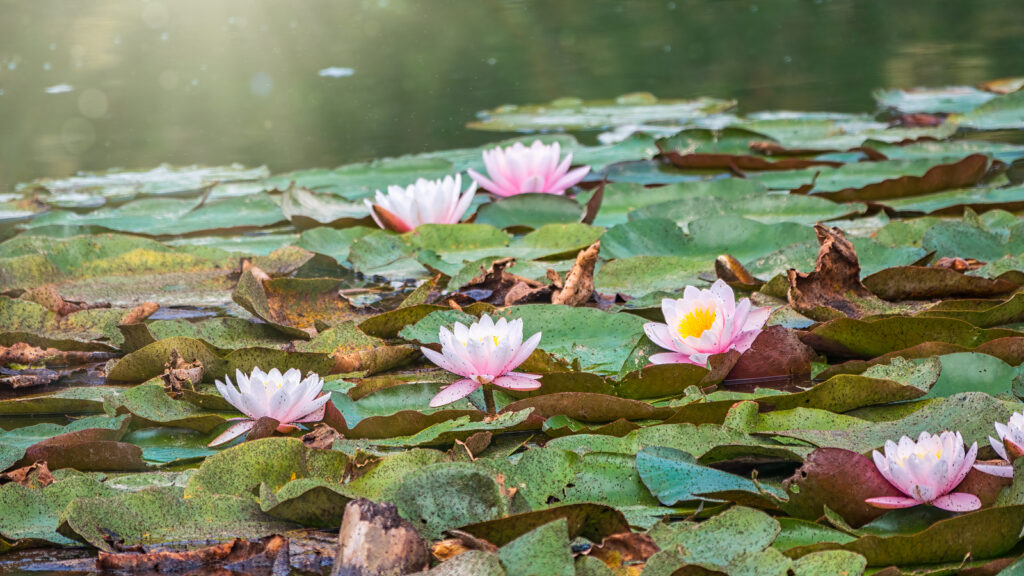Nymphaea — waterlily–is a large group of water plants with leaves that float on the water surface bearing showy flowers that either float on the surface or stand above it on stiff stalks. Cultivated water lilies commonly found in nurseries are largely hybrids; there are hardy types and tropical types.
Hardy waterlilies come in white, yellow, copper, pink, and red. Tropical types include all of the colors of hardy types plus blue and purple. Some tropicals in the white-pink-red color range are night bloomers; all others close at night. Most waterlilies are fragrant.
When purchasing waterlilies, be sure to choose varieties suitable for the depth of your pond. Hardy kinds are the easiest for beginners.
Most waterlilies bloom throughout the warm months and go dormant in fall, then reappear in spring. In cold winter regions, protect waterlilies by covering the pond or filling it deeper with water.
Get to know Nymphaea
- Plant type: Perennial.
- Growing zones and range: Zones 3 to 11 for hardy types; Zones 3 to 8 for tropical types.
- Hardiness: There are hardy and tropical types.
- Height and width: 4 to 10 feet (1.2-3m) wide depending on the variety
- Foliage: Leaves float and are rounded, with a deep notch at one side where the leaf stalk is attached; hardy types come in white, yellow, copper, pink, and red; tropical types are blue, purple, or an unusual greenish-blue; some tropical types are in the white-pink-red color range; they are night bloomers; all others close at night. All are fragrant.
- Flowers: Showy flowers with four sepals and numerous narrow petals and stamens either float on the water’s surface or stand above it on stiff stalks.
- Bloom time: Summer.
- Uses: Shallow pools, ponds, tubs, or slow-moving streams.
- Garden companions: Lotus (Nelumbo lutae)
- Common name: Waterlily
- Botanical name: Nymphaea
- Family name: Nymphaeaceae
- Origin: Worldwide

Where to plant Nymphaea
- Plant Nymphaea in full sun in shallow, undisturbed pools.
- Nymphaea produce more flowers in the sun.
When to plant Nymphaea
- Plant Nymphaea hardy types from late winter to mid-autumn; in mild-winter areas, spring to mid-summer.
Planting and spacing Nymphaea
- Choose selections suitable for the depth of your pond.
- Set 6 inch (15.2cm) long pieces of rhizome on the soil at the bottom or in boxes, placing rhizome in a nearly horizontal position with the bud end up. Cover the soil with washed gravel.
- The top of the soil should be 8-12 inches (20.3-30.1cm) below the surface of the water.
- For tropical kinds, buy started Nymphaea and set at the same depth as hardy rhizomes.
- When planting, lower the water level or raise the containers on bricks as necessary.
How to water and feed Nymphaea
- Enrich soil for Nymphaea with commercial organic fertilizer according to manufacturer’s instructions–usually 3 to 5 percent nitrogen) for each lily.
How to care for Nymphaea
- For tropical Nymphaea to grow in Zones 3 to 8, either treat them as annuals or take them indoors in winter.
- Groom Nymphaea by removing spent leaves and blooms.
- In very cold areas, protect by covering the pond or filling it deeper with water.
- Tropical types of Nymphaea go dormant but do not survive really low winter temperatures.
- Where winters are colder, store dormant Nymphaea tubers in damp sand over winter or buy new plants each year.
Nymphaea pests and diseases
- Nymphaea can develop leaf spots and rot.
- Nymphaea is susceptible to attack by aphids and beetles.
Nymphaea propagation
- Divide Nymphaea roots in early spring.
- Remove young plantlets from viviparous waterlilies in summer; pot and grow them on in shallow water until established.
Nymphaea varieties to grow
There are numerous species and cultivars of Nymphaea. Here are a few:
- Nymphaea, water lily.
- Marliac hybrids are among the best hardy waterlilies, in various shades of red, pink, yellow, and apricot.
- N. ‘Director Moore’, a tropical, has deep violet-blue flowers with gold centers.
- N. ‘Mrs. George T. Hitchcock’, a night-blooming tropical, has rosy-pink flowers.
- N. lotus, Egyptian waterlily: tropical waterlily with round dark green leaves; cultivars include ‘Louise’ with red flowers; ‘Lucida’ star-shaped with red inner petals; ‘Madame Ganna Walska’ with pointed violet-pink petals.
- N. mexicana star-shaped pale to bright yellow flowers; tropical waterlily.
- N. odorata, the hardy, fragrant, native waterlily, bears waxy white, 4-6 inch (10.2-15.2cm) wide blooms; one of the easiest waterlilies to grow; dig it from shallow ponds and transplant it nearly any time; among the many cultivars available commercially are ‘Pink Sensation’, ‘Radiant Red’, and the yellow ‘Sulphurea’.
- N. tetragona, hardy waterlily; cup-shaped, slightly fragrant flowers; several named varieties; day-blooming, cup-shaped flowers.
- N. tuberosa, Magnolia waterlily, also a native, has white flowers that are 6-9 inches (15.2-22.9cm), but it is only slightly fragrant; blooms mostly in the morning and closes tight during the late afternoon and evening.



